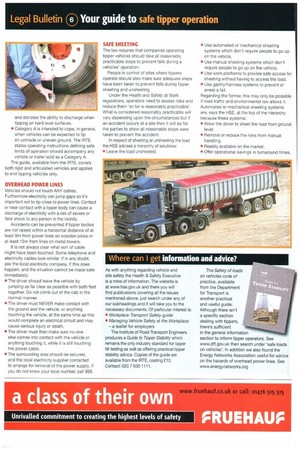and denotes the ability to discharge when tipping on hard level surfaces.
Page 29

If you've noticed an error in this article please click here to report it so we can fix it.
• Category A is intended to cope, in general, when vehicles can be expected to tip on unmade or uneven ground. The IRTE states operating instructions defining safe limits of operation should accompany any vehicle or trailer sold as a Category A. The guide, available from the IRTE, covers both rigid and articulated vehicles and applies to end tipping vehicles only.
OVERHEAD POWER LINES
Vehicles should not touch ANY cables. Furthermore electricity can jump gaps so it's important not to tip close to power lines. Contact or near contact with a tipper body can cause a discharge of electricity with a risk of severe or fatal shock to any person in the vicinity.
Accidents can be prevented if tipper bodies are not raised within a horizontal distance of at least 9m from power lines on wooden poles or at least 15m from lines on metal towers.
It is not always clear what sort of cable might have been touched. Some telephone and electricity cables look similar. If in any doubt, ask the local electricity company. If this does happen, and the situation cannot be made safe immediately: • The driver should leave the vehicle by jumping as far clear as possible with both feet together. Do not climb out of the cab in the normal manner.
• The driver must NEVER make contact with the ground and the vehicle, or anything touching the vehicle, at the same time as this would complete an electrical circuit and may cause serious injury or death.
• The driver must then make sure no-one else comes into contact with the vehicle or anything touching it, while it is still touching the power cable.
• The surrounding area should be secured, and the local electricity supplier contacted to arrange for removal of the power supply. If you do not know your local number, call 999.
SAFE SHEETING
The law requires that companies operating tipper vehicles should take all reasonably practicable steps to prevent falls during a vehicles' operation.
People in control of sites where tippers operate should also make sure adequate steps have been taken to prevent falls during tipper sheeting and unsheeting.
Under the Health and Safety at Work regulations, operators need to assess risks and reduce them so far is reasonably practicable'. What is considered reasonably practicable will vary depending upon the circumstances but if an accident occurs at a site then it will be for the parties to show all reasonable steps were taken to prevent the accident.
In respect of sheeting or unsheeting the load the HSE advises a hierarchy of solutions: • Leave the load unsheeted. • Use automated or mechanical sheeting systems which don't require people to go up on the vehicle.
• Use manual sheeting systems which don't require people to go up on the vehicle.
• Use work platforms to provide safe access for sheeting without having to access the load.
• Use gantry/harness systems to prevent or arrest a fail.
Regarding the former, this may only be possible if road traffic and environmental law allows it. Automated or mechanical sheeting systems are, says the HSE, at the top of the hierarchy because these systems: • Allow the driver to sheet the load from ground level.
• Remove or reduce the risks from manual handling.
• Readily available on the market.
• Offer operational savings in turnaround times.






































































































































































































